Deconvolution Benchmark in Human DLPFC
Louise Huuki-Myers
Lieber Institute for Brain Development, Johns Hopkins Medical Campuslahuuki@gmail.com
28 July 2025
Source:vignettes/Deconvolution_Benchmark_DLPFC.Rmd
Deconvolution_Benchmark_DLPFC.RmdIntroduction
What is Deconvolution?
Inferring the composition of different cell types in a bulk RNA-seq data
Deconvolution is a analysis that aims to calculate the proportion of different cell types that make up a sample of bulk RNA-seq, based off of cell type gene expression profiles in a single cell/nuclei RNA-seq dataset.
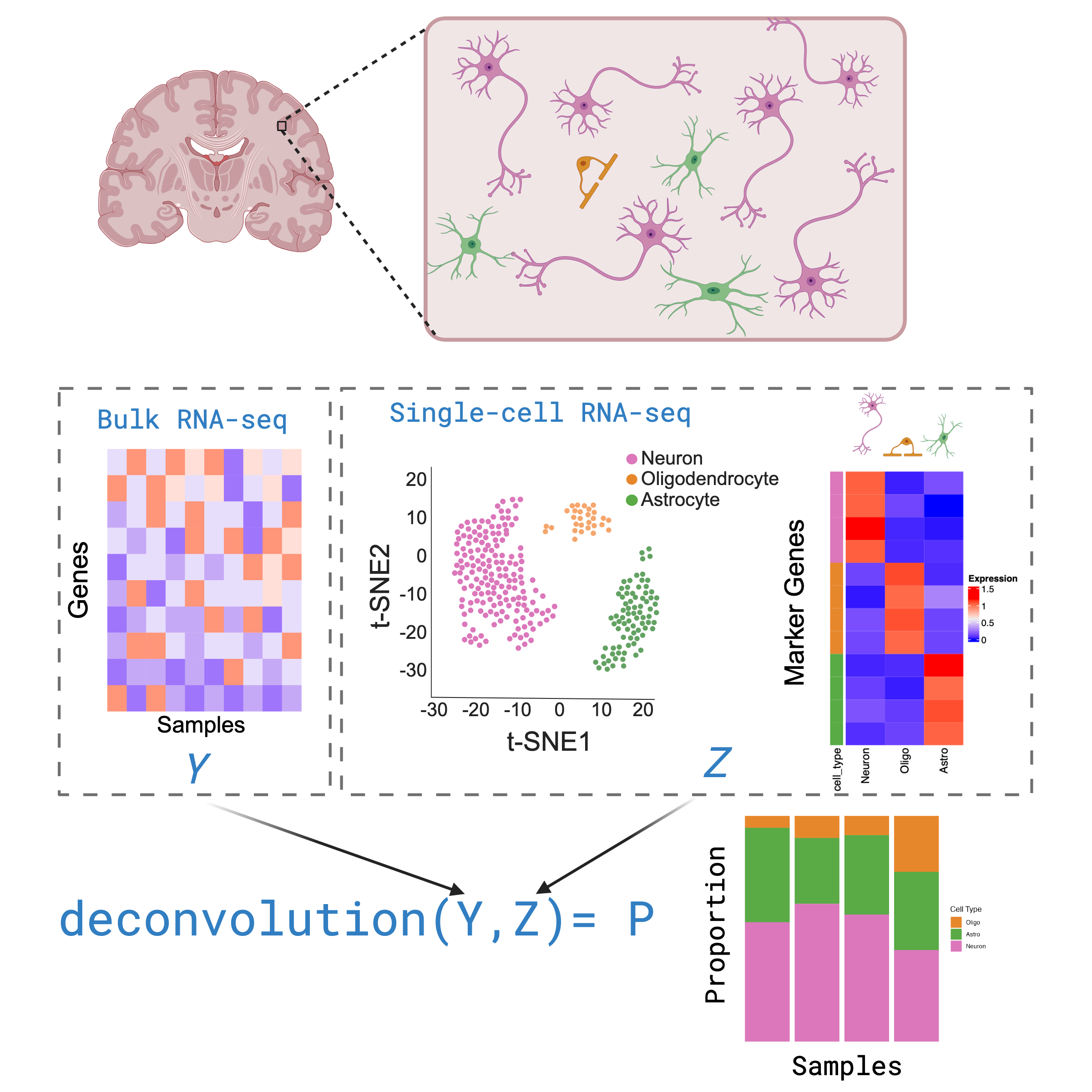
Deconvolution Methods
There are 20+ published reference based deconvolution methods. Below are a selection of 6 methods we tested in our deconvolution benchmark study.
| Approach | Method | Citation | Availability |
|---|---|---|---|
| weighted least squares | DWLS | Tsoucas et al, Nature Comm, 2019 | R Package CRAN |
| Bias correction: Assay | Bisque | Jew et al, Nature Comm, 2020 | R Package GitHub |
| Bias correction: Source | MuSiC | Wang et al, Nature Communications, 2019 | R Package GitHub |
| Machine Learning | CIBERSORTx | Newman et al., Nature BioTech, 2019 | Webtool |
| Bayesian | BayesPrism | Chu et al., Nature Cancer, 2022 | Webtool/R Package |
| linear | Hspe | Hunt et al., Ann. Appl. Stat, 2021 | R package GitHub |
Goals of this Vignette
We will be demonstrating how to use DeconvoBuddies tools
when applying deconvolution with the Bisque package.
- Install and load required packages
- Download DLPFC RNA-seq data, and reference snRNA-seq data
- Find marker genes with
DeconvoBuddiestools - Run deconvolution with
BisqueRNA - Explore deconvolution output and create composition plots with
DeconvoBuddiestools - Check proportion against RNAScope estimated proportions
Video Tutorial
Linked is a video from a presentation of an earlier version of this tutorial from our LIBD Rstats club.
1. Install and load required packages
R is an open-source statistical environment which can be
easily modified to enhance its functionality via packages. DeconvoBuddies
is a R package available via the Bioconductor repository for packages.
R can be installed on any operating system from CRAN after which you can install
DeconvoBuddies
by using the following commands in your R session:
Install DeconvoBuddies
if (!requireNamespace("BiocManager", quietly = TRUE)) {
install.packages("BiocManager")
}
BiocManager::install("DeconvoBuddies")
## Check that you have a valid Bioconductor installation
BiocManager::valid()Load Other Packages
Let’s load the packages we’ll be using in this vignette.
## Packages for different types of RNA-seq data structures in R
library("SummarizedExperiment")
library("SingleCellExperiment")
library("Biobase")
## For downloading data
library("spatialLIBD")
## Other helper packages for this vignette
library("dplyr")
library("tidyr")
library("tibble")
library("ggplot2")
## Our main package
library("DeconvoBuddies")2. Download DLPFC RNA-seq data, and reference snRNA-seq data.
Bulk RNA-seq data
Access the 110 sample Human DLPFC bulk RNA-seq dataset for LIBD
described in more detail here.
These samples
are from 19 tissue blocks, and 10 neurotypical adult donors. Samples
were sequenced with two different library_types (polyA and
RiboZeroGold), and three different RNA_extraction (Cyto,
Total, Nuc). There are in total n=110 samples after quality control.
## use fetch deconvo data to load rse_gene
rse_gene <- fetch_deconvo_data("rse_gene")
#> 2025-07-28 19:55:13.312778 Access ExperimentHub EH9625
#> see ?DeconvoBuddies and browseVignettes('DeconvoBuddies') for documentation
#> loading from cache
rse_gene
#> class: RangedSummarizedExperiment
#> dim: 21745 110
#> metadata(1): SPEAQeasy_settings
#> assays(2): counts logcounts
#> rownames(21745): ENSG00000227232.5 ENSG00000278267.1 ...
#> ENSG00000210195.2 ENSG00000210196.2
#> rowData names(11): Length gencodeID ... gencodeTx passExprsCut
#> colnames(110): 2107UNHS-0291_Br2720_Mid_Bulk
#> 2107UNHS-0291_Br2720_Mid_Cyto ... AN00000906_Br8667_Mid_Cyto
#> AN00000906_Br8667_Mid_Nuc
#> colData names(80): SAMPLE_ID Sample ... diagnosis qc_class
# lobstr::obj_size(rse_gene)
# 41.16 MB
## Use gene "Symbol" as identifiers for the genes in rownames(rse_gene)
rownames(rse_gene) <- rowData(rse_gene)$Symbol
## bulk RNA seq samples were sequenced with different library types,
## and RNA extractions
table(rse_gene$library_type, rse_gene$library_prep)
#>
#> Bulk Cyto Nuc
#> polyA 19 18 18
#> RiboZeroGold 19 19 17Reference snRNA-seq data
This data is paired with a single nucleus RNA-seq data set from
spatialLIBD. This dataset can be accessed with
spatialLIBD::fetch_data().
## Use spatialLIBD to fetch the snRNA-seq dataset used in this project
sce_path_zip <- fetch_deconvo_data("sce")
#> 2025-07-28 19:55:17.447848 loading file /github/home/.cache/R/BiocFileCache/20110218742_sce_DLPFC_annotated.zip%3Fdl%3D1
## unzip and load the data
sce_path <- unzip(sce_path_zip, exdir = tempdir())
sce <- HDF5Array::loadHDF5SummarizedExperiment(
file.path(tempdir(), "sce_DLPFC_annotated")
)
# lobstr::obj_size(sce)
# 172.28 MB
## exclude Ambiguous cell type
sce <- sce[, sce$cellType_broad_hc != "Ambiguous"]
sce$cellType_broad_hc <- droplevels(sce$cellType_broad_hc)
## Check the number of genes by the number of nuclei that we
## have to work with:
dim(sce)
#> [1] 36601 56447
## Check the broad cell type distribution
table(sce$cellType_broad_hc)
#>
#> Astro EndoMural Micro Oligo OPC Excit Inhib
#> 3979 2157 1601 10894 1940 24809 11067
## We're going to subset to the first 5k genes to save memory
## just for this example. You wouldn't do this on a full analysis.
sce <- sce[seq_len(5000), ]Orthogonal Cell Type Proportion from RNAScope/IF
An alternative method for calculating cell type proportions is through imaging a slice of tissue with cell type probes using single molecule fluorescent in situ hybridization (smFISH) experiments performed with RNAScope/IF (ImmunoFluorescence). Then analyse the image to count cells and annotate them by cell type. In this study we used HALO from Indica Labs for this step.
The cell type proportions from the RNAScope/IF experiment will be used to evaluate the accuracy of cell type proportion estimates.
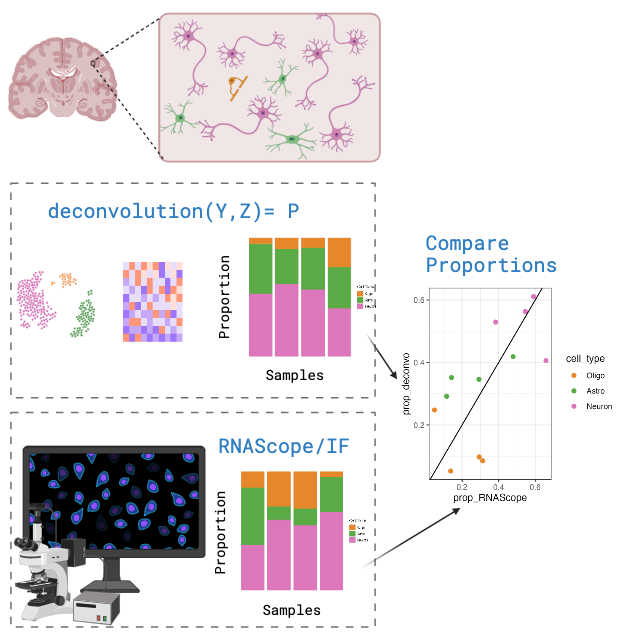
The RNAScope/IF proportion data is stored as a
data.frame object in
DeconvoBuddies::RNAScope_prop.
Key columns in RNAScope_prop:
SAMPLE_ID: DLPFC Tissue block + RNAScope combination.Sample: DLFPC Tissue block (Donor BrNum + DLPFC position).cell_type: The cell type measured.n_cell: the number of cells counted for the Sample and cell type.prop: the calculated cell type proportion from n_cell
# Access the RNAScope proportion data.frame
data("RNAScope_prop")
head(RNAScope_prop)
#> SAMPLE_ID Sample Combo cell_type Confidence n_cell prop
#> 1 Br2720P_CIRCLE Br2720_post Circle Astro High 3385 0.09357808
#> 2 Br2720P_CIRCLE Br2720_post Circle EndoMural High 1680 0.04644348
#> 3 Br2720P_CIRCLE Br2720_post Circle Inhib High 3092 0.08547812
#> 4 Br2720P_CIRCLE Br2720_post Circle Other High 28016 0.77450032
#> 5 Br2720P_STAR Br2720_post Star Excit High 8687 0.23132639
#> 6 Br2720P_STAR Br2720_post Star Micro High 1416 0.03770671
#> n_cell_sn prop_sn
#> 1 81 0.04287983
#> 2 66 0.03493912
#> 3 94 0.04976178
#> 4 NA NA
#> 5 1198 0.63419799
#> 6 47 0.02488089
## plot the RNAScope compositions
plot_composition_bar(
prop_long = RNAScope_prop,
sample_col = "SAMPLE_ID",
x_col = "SAMPLE_ID",
add_text = FALSE
) +
facet_wrap(~Combo, nrow = 2, scales = "free_x")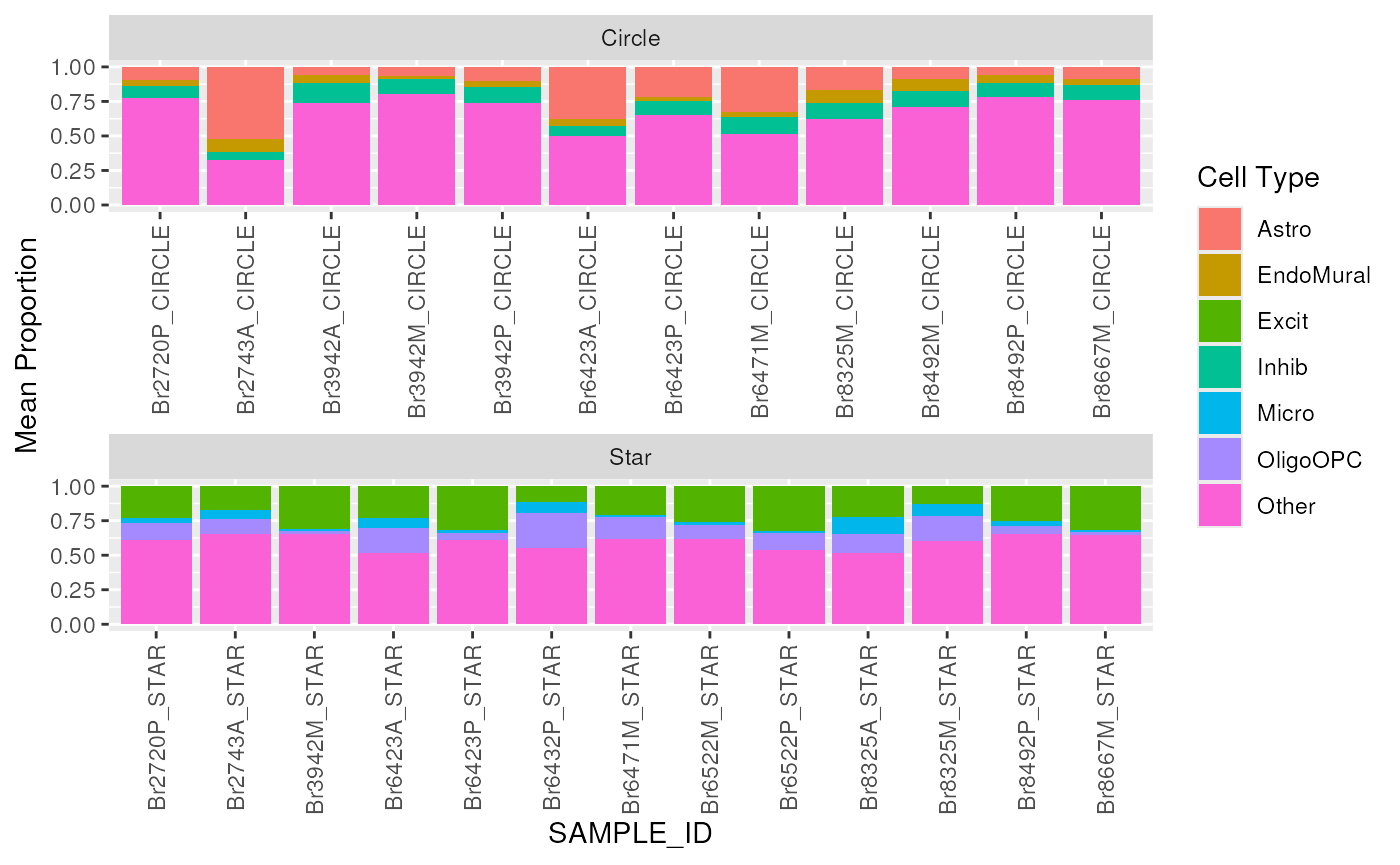
Above we can see the cell proportions for each of the samples in
either the Circle or the Star combination of
RNAScope/IF probes. Each combination of RNAScope/IF probes was able to
assess different sets of cell types. Two of them had to be used to
measure the number of cell types studied in this case as there are
limits on how many unique probes you can measure in a given RNAScope/IF
experiment. For more details about the RNAScope/IF combinations, check
the paper describing this
study.
3. Select Marker Genes
Marker genes are genes with high expression in one cell type and low expression in other cell types, or “cell-type specific” expression. These genes can be used to learn more about the identity and function of cell types, but here we are interested in using a sets of cell type specific marker genes to reduce noise in deconvolution and increase accuracy.
We have developed a method for finding marker genes called the “Mean Ratio”. We calculate the MeanRatio for a target cell type for each gene by dividing the mean expression of the target cell by the mean expression of the next highest non-target cell type. Genes with the highest MeanRatio values are selected as marker genes.
For a tutorial on marker gene selection check out Vignette: Finding Marker Genes with Deconvo Buddies.
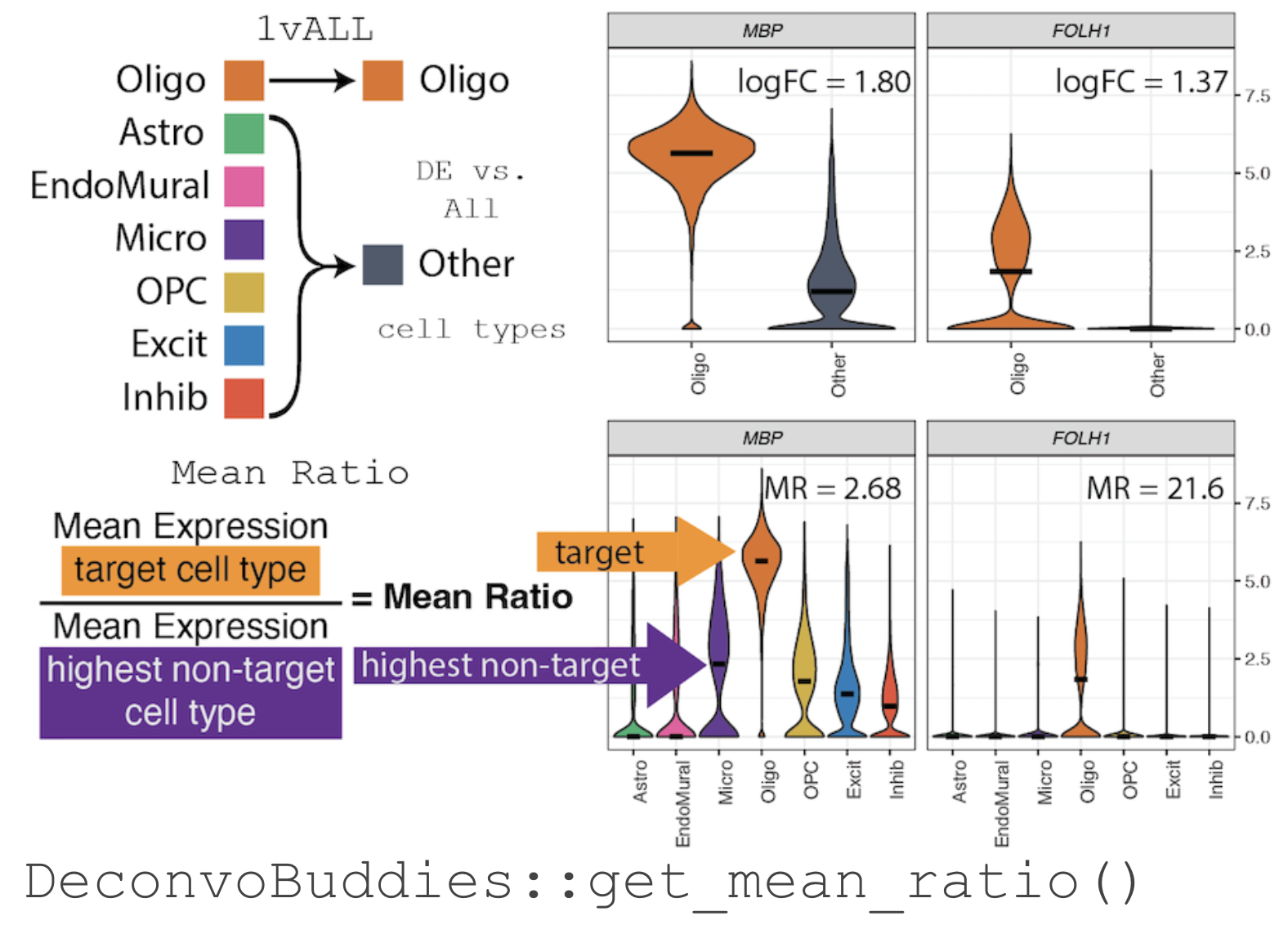
Use get_mean_ratio() to find marker genes.
The function DeconvoBuddies::get_mean_ratio() calculates
the MeanRatio and the rank of genes for a specified cell type
annotation in an SingleCellExperiment object.
# calculate the Mean Ratio of genes for each cell type
marker_stats <- get_mean_ratio(sce,
cellType_col = "cellType_broad_hc",
gene_ensembl = "gene_id",
gene_name = "gene_name"
)
# check the top gene ranked gene for each cell type
marker_stats |>
group_by(cellType.target) |>
slice(1)
#> # A tibble: 7 × 10
#> # Groups: cellType.target [7]
#> gene cellType.target mean.target cellType.2nd mean.2nd MeanRatio
#> <chr> <fct> <dbl> <fct> <dbl> <dbl>
#> 1 PRDM16 Astro 1.97 EndoMural 0.142 13.9
#> 2 SLC2A1 EndoMural 1.49 Astro 0.146 10.2
#> 3 LINC01141 Micro 1.57 Excit 0.0640 24.5
#> 4 AC012494.1 Oligo 2.37 OPC 0.147 16.1
#> 5 MIR3681HG OPC 1.58 Excit 0.205 7.69
#> 6 AC011995.2 Excit 1.01 Inhib 0.135 7.51
#> 7 LYPD6B Inhib 1.20 Excit 0.0967 12.4
#> # ℹ 4 more variables: MeanRatio.rank <int>, MeanRatio.anno <chr>,
#> # gene_ensembl <chr>, gene_name <chr>The columns of this table are documented in detail at
DeconvoBuddies::get_mean_ratio(). Though
cellType.target lists the target cell type for which the
MeanRatio is being calculated. It is the numerator of the
MeanRatio. The cellType.2nd lists the cell type
against which the target cell type is being compared. It is the
denominator of the MeanRatio.
Plot the top marker genes
Use DeconvoBuddies plotting tools to quickly plot the
gene expression of the top 4 Excitatory neuron marker genes across the
cellType_broad_hc cell type annotations.
# plot expression across cell type the top 4 Excit marker genes
plot_marker_express(sce,
stats = marker_stats,
cell_type = "Excit",
cellType_col = "cellType_broad_hc",
rank_col = "MeanRatio.rank",
anno_col = "MeanRatio.anno",
gene_col = "gene"
)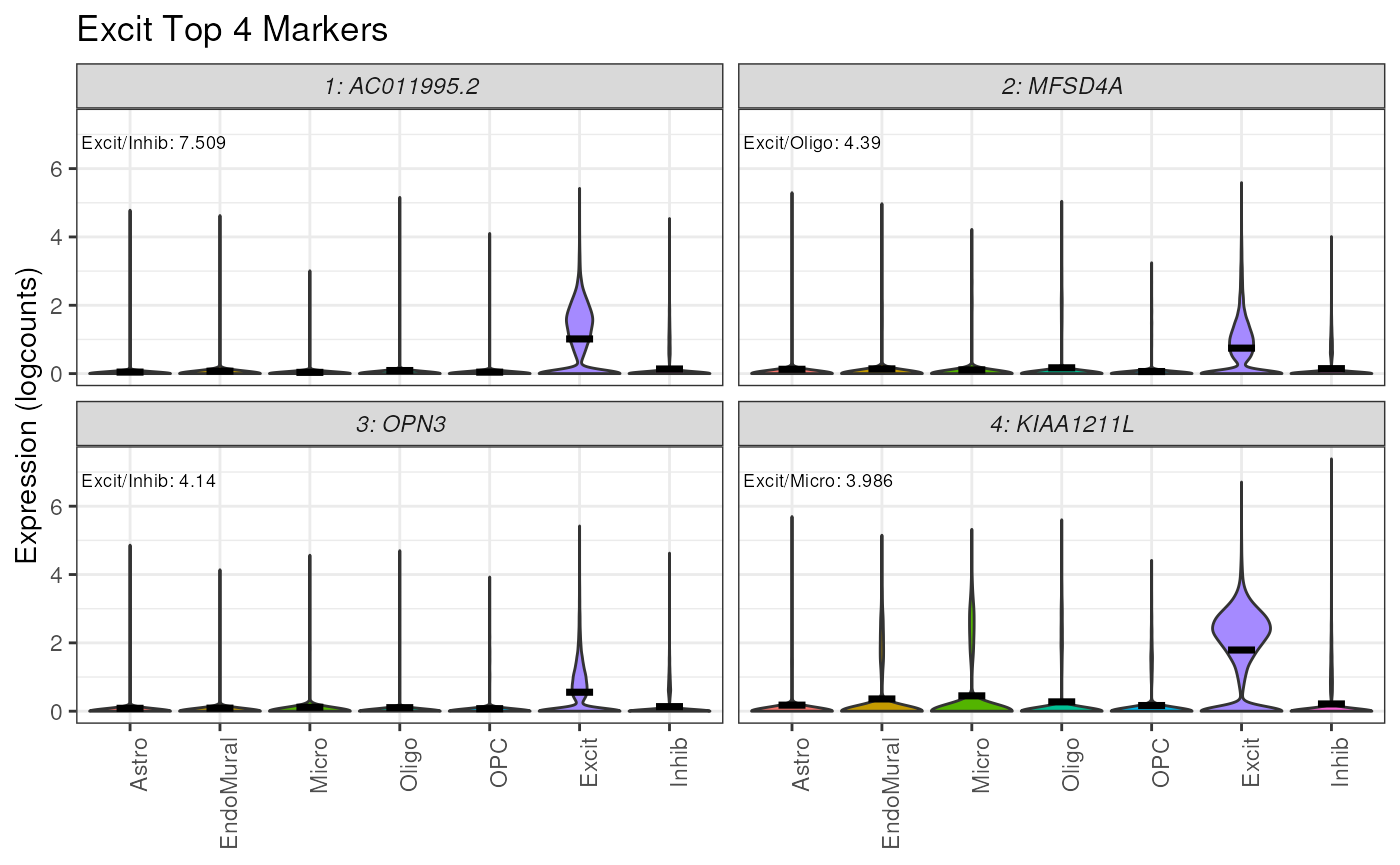
Looks nice and cell type specific!
Note how plot_marker_express() lists the 2 cell types
that are being compared that result in the specific numerical
MeanRatio value being displayed. As we specified that our
target cell type is "Excit" in our call to
plot_marker_express(), the numerator is Excit
in all the panels shown above.
Create a List of Marker Genes
With the MeanRatio calculated, we will select the top 25
highest Mean Ratio genes for each cell type, that also exists in the
bulk data rse_gene.
# select top 25 marker genes for each cell type, that are also in rse_gene
marker_genes <- marker_stats |>
filter(MeanRatio.rank <= 25 & gene %in% rownames(rse_gene))
# check how many genes for each cell type (some genes are not in both datasets)
marker_genes |> count(cellType.target)
#> # A tibble: 7 × 2
#> cellType.target n
#> <fct> <int>
#> 1 Astro 22
#> 2 EndoMural 25
#> 3 Micro 24
#> 4 Oligo 23
#> 5 OPC 22
#> 6 Excit 21
#> 7 Inhib 24
# create a vector of marker genes to subset data before deconvolution
marker_genes <- marker_genes |> pull(gene)4. Prep Data and Run Bisque
Bisque is
an R package for cell type deconvolution. In our deconvolution
benchmark, we found it was a top performing method. Below we will
briefly show how to run Bisque’s “reference based
decomposition (deconvolution)”.
Prepare data
To run Bisque the snRNA-seq and bulk data must first be
converted to Biobase::ExpressionSet() format. We will
subset our data to our selected MeanRatio marker genes.
The snRNA-seq data must also be filtered for cells with no counts across marker genes.
# NOT RUN - no longer running Bisque - see next section for details
if(FALSE){
## convert bulk data to Expression set, sub-setting to marker genes
## include sample ID
exp_set_bulk <- Biobase::ExpressionSet(
assayData = assays(rse_gene[marker_genes, ])$counts,
phenoData = AnnotatedDataFrame(
as.data.frame(colData(rse_gene))[c("SAMPLE_ID")]
)
)
## convert snRNA-seq data to Expression set, sub-setting to marker genes
## include cell type and donor information
exp_set_sce <- Biobase::ExpressionSet(
assayData = as.matrix(assays(sce[marker_genes, ])$counts),
phenoData = AnnotatedDataFrame(
as.data.frame(colData(sce))[, c("cellType_broad_hc", "BrNum")]
)
)
## check for nuclei with 0 marker expression
zero_cell_filter <- colSums(exprs(exp_set_sce)) != 0
message("Exclude ", sum(!zero_cell_filter), " cells")
exp_set_sce <- exp_set_sce[, zero_cell_filter]
}Run Bisque
Bisque needs the bulk and single cell
ExpressionSet we prepared above, plus columns in the single
cell data that specify the cell type annotation to use
cellType_broad_hc and donor id (BrNum in this
data).
NOTE: Bisque is no longer available on CRAN (as of July 2025) so cannot be run in this vignette. We’ll use pre-computed estimates for this vignette instead. (loaded in the next section).
## NOT RUN - Bisque unavailable on CRAN
## Run Bisque with bulk and single cell ExpressionSet inputs
## For running deconvolution
# But the development version can be installed from github via:
# devtools::install_github("cozygene/bisque")
if(FALSE){
# library("BisqueRNA")
est_prop <- ReferenceBasedDecomposition(
bulk.eset = exp_set_bulk,
sc.eset = exp_set_sce,
cell.types = "cellType_broad_hc",
subject.names = "BrNum",
use.overlap = FALSE
)
## Examine the output from Bisque, transpose to make it easier to work with
est_prop <- t(est_prop$bulk.props)
}Explore Output
Bisque predicts the proportion of the cell types in
cellType_broad_hc for each sample in the bulk data.
## Load the pre-computed estimated proportions
data("est_prop")
## sample x cell type matrix
head(est_prop)
#> Astro EndoMural Micro Oligo
#> 2107UNHS-0291_Br2720_Mid_Bulk 0.03620838 0.01450229 0.00822044 0.1898306
#> 2107UNHS-0291_Br2720_Mid_Cyto 0.04270700 0.01480779 0.02118528 0.1624367
#> 2107UNHS-0291_Br2720_Mid_Nuc 0.04792806 0.03613114 0.02192201 0.1584692
#> 2107UNHS-0291_Br6432_Ant_Bulk 0.05450912 0.02715661 0.01473154 0.1668393
#> 2107UNHS-0291_Br6432_Ant_Cyto 0.05722515 0.02115855 0.03127993 0.1432068
#> 2107UNHS-0291_Br6432_Ant_Nuc 0.05762778 0.03489159 0.02267823 0.1543922
#> OPC Excit Inhib
#> 2107UNHS-0291_Br2720_Mid_Bulk 0.06093697 0.4041093 0.2861921
#> 2107UNHS-0291_Br2720_Mid_Cyto 0.02924472 0.4800840 0.2495345
#> 2107UNHS-0291_Br2720_Mid_Nuc 0.03148864 0.4617759 0.2422850
#> 2107UNHS-0291_Br6432_Ant_Bulk 0.11035566 0.3911678 0.2352399
#> 2107UNHS-0291_Br6432_Ant_Cyto 0.05399435 0.5010104 0.1921248
#> 2107UNHS-0291_Br6432_Ant_Nuc 0.08059862 0.4445150 0.20529665. Explore deconvolution output and create composition plots with
DeconvoBuddies tools
To visualize the cell type proportion predictions, we can plot cell
type composition bar plots with
DeconvoBuddies::plot_composition_bar(), either the
prediction for each sample, or the average proportion over a group of
samples.
## add Phenotype data to proportion estimates
pd <- colData(rse_gene) |>
as.data.frame() |>
select(SAMPLE_ID, Sample, library_combo)
## make proportion estimates long so they are ggplot2 friendly
prop_long <- est_prop |>
as.data.frame() |>
tibble::rownames_to_column("SAMPLE_ID") |>
tidyr::pivot_longer(!SAMPLE_ID, names_to = "cell_type", values_to = "prop") |>
left_join(pd)
#> Joining with `by = join_by(SAMPLE_ID)`
## create composition bar plots
## for all library preparations by sample n=110
## Remove the SAMPLE_ID names since they are very long using ggplot2::theme()
plot_composition_bar(
prop_long = prop_long,
sample_col = "SAMPLE_ID",
x_col = "SAMPLE_ID",
add_text = FALSE
) +
theme(axis.text.x = element_blank(), axis.ticks.x = element_blank())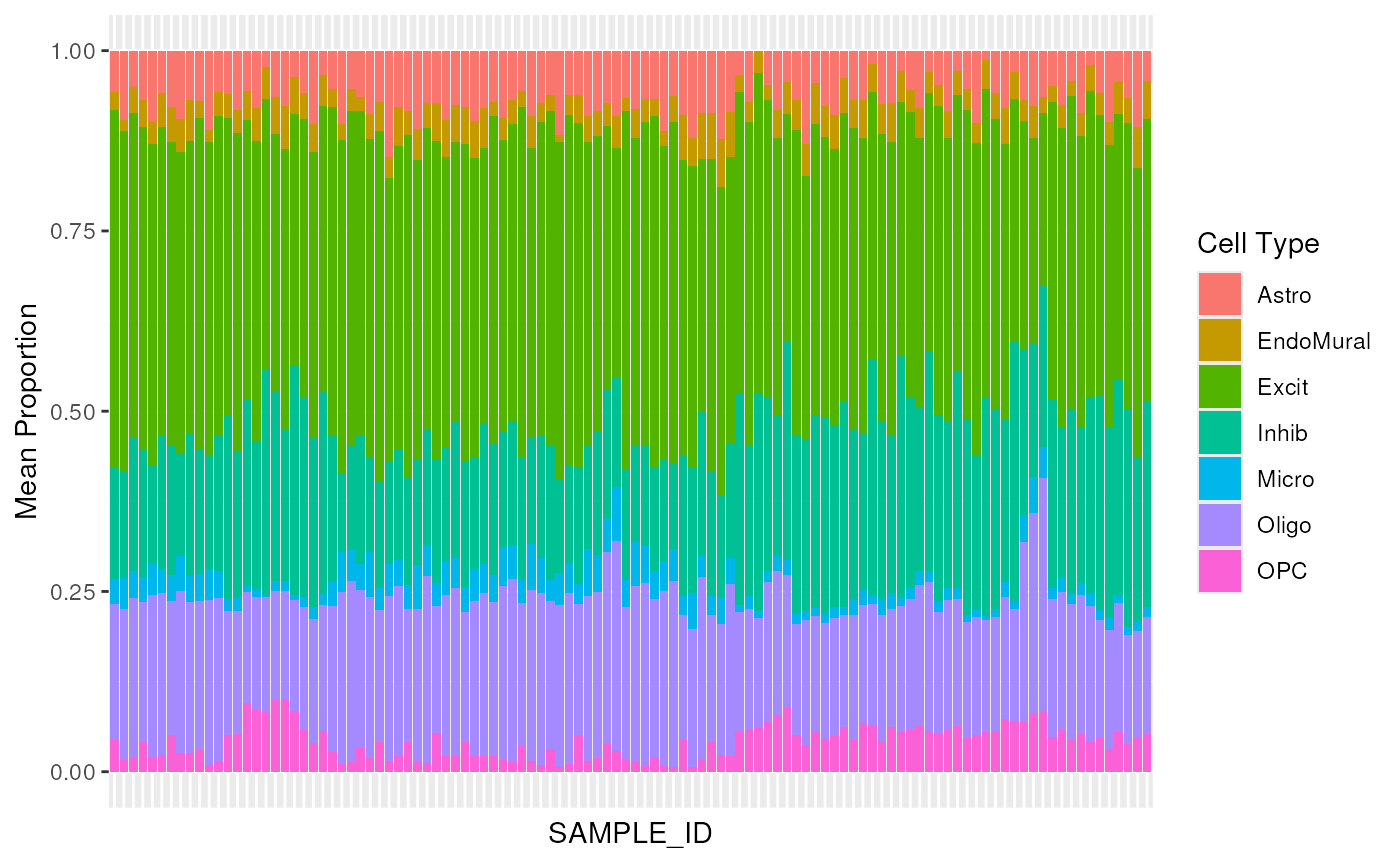
## Average by brain donor
plot_composition_bar(
prop_long = prop_long,
sample_col = "SAMPLE_ID",
x_col = "Sample",
add_text = FALSE
)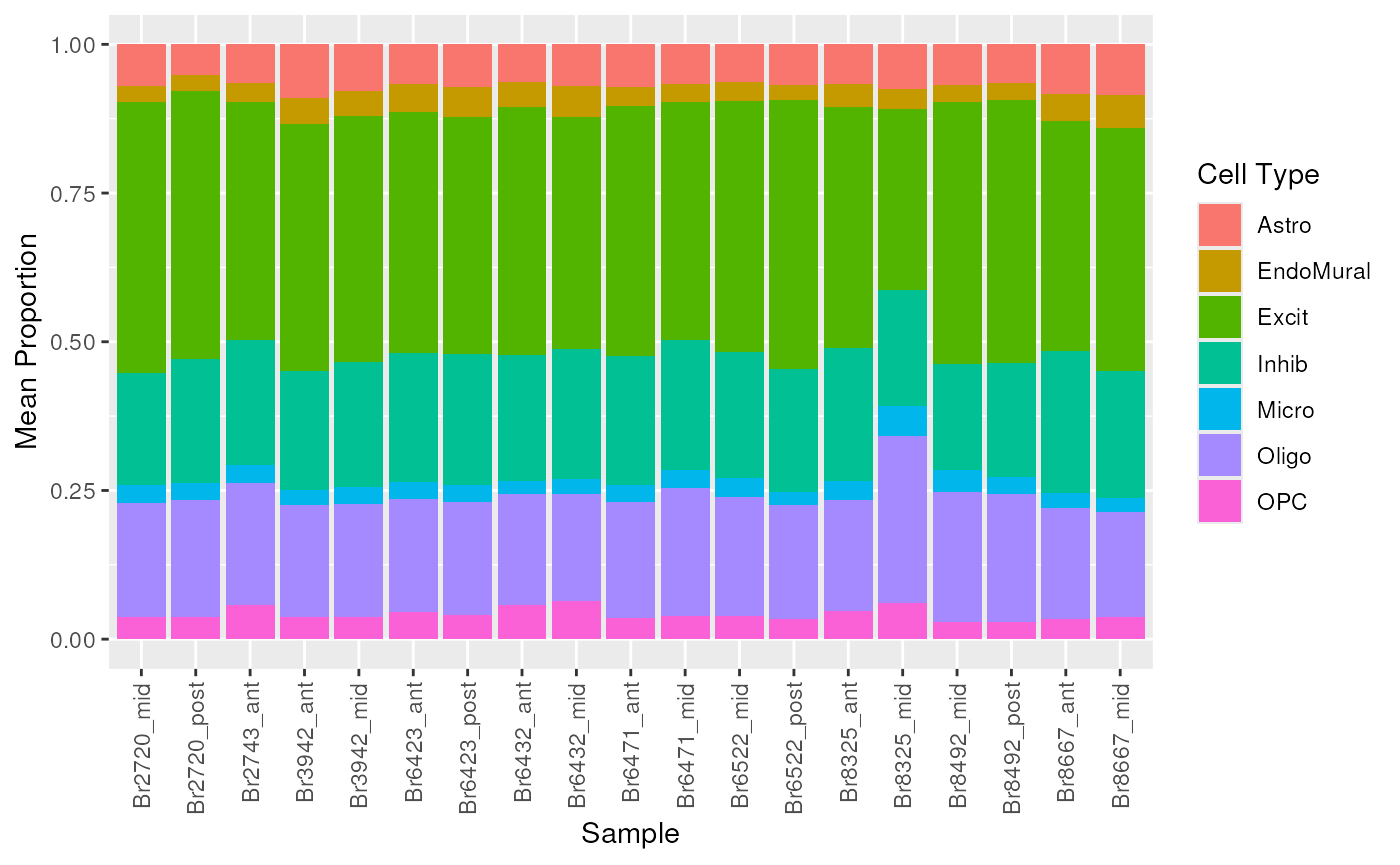
## Each brain donor has up to 6 unique RNA library type and RNA extraction
## combinations
table(prop_long$Sample) / length(unique(prop_long$cell_type))
#>
#> Br2720_mid Br2720_post Br2743_ant Br3942_ant Br3942_mid Br6423_ant
#> 5 6 5 6 6 6
#> Br6423_post Br6432_ant Br6432_mid Br6471_ant Br6471_mid Br6522_mid
#> 6 6 6 6 6 6
#> Br6522_post Br8325_ant Br8325_mid Br8492_mid Br8492_post Br8667_ant
#> 6 6 5 5 6 6
#> Br8667_mid
#> 6
## Here are the 6 "SAMPLE_ID" values for brain donor with ID "Br8667_mid"
unique(prop_long$SAMPLE_ID[prop_long$Sample == "Br8667_mid"])
#> [1] "AN00000904_Br8667_Mid_Bulk" "AN00000904_Br8667_Mid_Cyto"
#> [3] "AN00000904_Br8667_Mid_Nuc" "AN00000906_Br8667_Mid_Bulk"
#> [5] "AN00000906_Br8667_Mid_Cyto" "AN00000906_Br8667_Mid_Nuc"This is a more complex scenario than the one from the introductory vignette where we were using random data. The first plot shows each of the n=110 bulk RNA-seq samples we have. The second plot shows the composition using the average across the 6 RNA library types and RNA extractions for each brain donor.
6. Check proportion against RNAScope/IF estimated proportions
Note to compare the deconvolution results to the RNAScope/IF proportions, Oligo and OPC need to be added together.
## Combine Oligo and OPC into OligoOPC
prop_long_opc <- prop_long |>
mutate(cell_type = gsub("Oligo|OPC", "OligoOPC", cell_type)) |>
group_by(SAMPLE_ID, Sample, library_combo, cell_type) |>
summarize(prop = sum(prop)) |>
ungroup()
#> `summarise()` has grouped output by 'SAMPLE_ID', 'Sample', 'library_combo'. You
#> can override using the `.groups` argument.
prop_long_opc |> count(cell_type)
#> # A tibble: 6 × 2
#> cell_type n
#> <chr> <int>
#> 1 Astro 110
#> 2 EndoMural 110
#> 3 Excit 110
#> 4 Inhib 110
#> 5 Micro 110
#> 6 OligoOPC 110
## Join RNAScope/IF and Bisque cell type proportions
prop_compare <- prop_long_opc |>
inner_join(
RNAScope_prop |>
select(Sample, cell_type, prop_RNAScope = prop, prop_sn),
by = c("Sample", "cell_type")
)We can now calculate the correlation plot a scatter plot of the
proportions. Note that you can change the type of correlation algorithm
used in the cor() function. The default method is
"pearson".
## compute correlation with RNAScope/IF proportions
cor(prop_compare$prop, prop_compare$prop_RNAScope)
#> [1] 0.5339794
## Scatter plot with RNAScope/IF proportions
prop_compare |>
ggplot(aes(x = prop_RNAScope, y = prop, color = cell_type, shape = library_combo)) +
geom_point() +
geom_abline()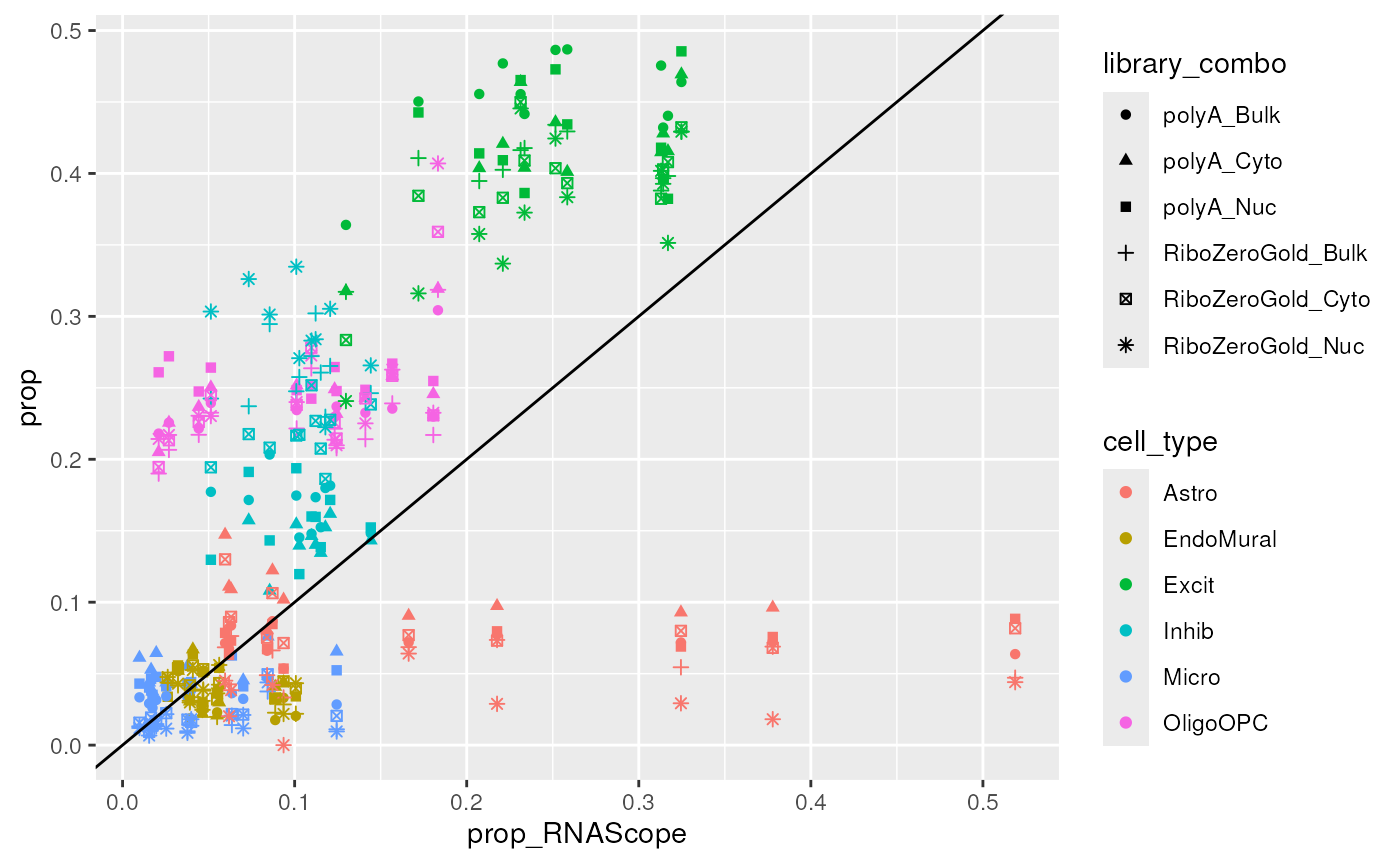
## correlation with snRNA-seq proportion
cor(prop_compare$prop, prop_compare$prop_sn)
#> [1] 0.8212221
## Scatter plot with RNAScope/IF proportions
prop_compare |>
ggplot(aes(x = prop_sn, y = prop, color = cell_type, shape = library_combo)) +
geom_point() +
geom_abline()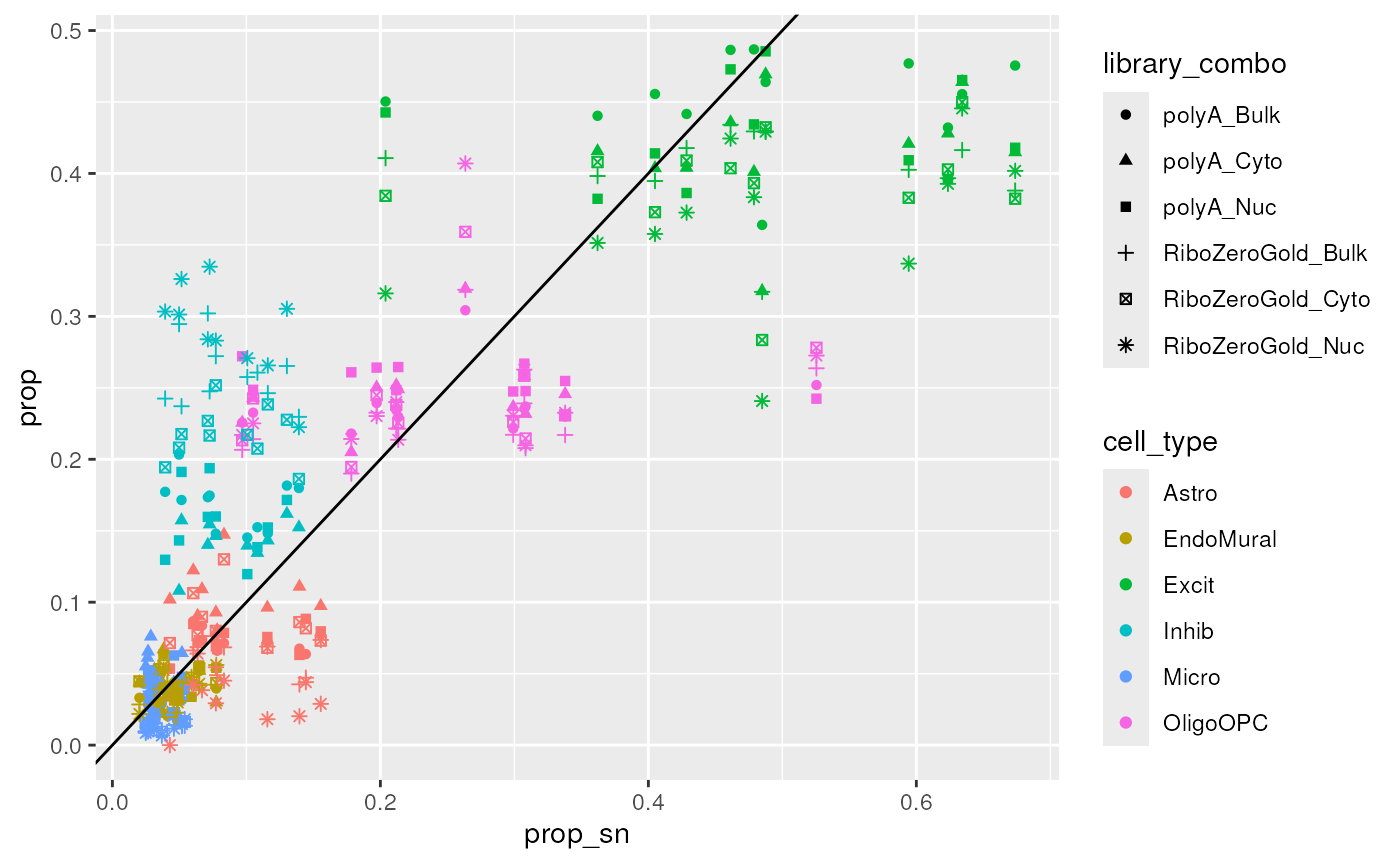
In the first plot we can see how Bisque overestimates
the proportion of excitatory neurons (Excit) when compared
against RNAScope/IF as all Excit points are higher than the
diagonal line shown in black.
In the second plot we can see how Bisque proportions are
closer to the snRNA-seq proportions. After all, given the challenges in
generating orthogonal cell type proportion data, Bisque
and other deconvolution methods were developed by comparing against
simulated data, sometimes using pseudo-bulk sc/snRNA-seq data.
7. How to run deconvolution with hspe
hspe (formerly called dtangle) is another R package for deconvolution. It was also a top performing method in our deconvolution benchmark.
hspe is downloadable from GitHub but
can’t be shown on this vignette as Bioconductor packages cannot use
packages from GitHub.
Below we show some example code to prepare input data and run
hspe (not run here):
if (FALSE) {
## Install hspe
# if (!requireNamespace("hspe", quietly = TRUE)) {
# ## Install version 0.1 which is the one listed on the main documentation
# ## at https://github.com/gjhunt/hspe/tree/main?tab=readme-ov-file#software
# remotes::install_url("https://github.com/gjhunt/hspe/raw/main/hspe_0.1.tar.gz")
# ## Alternatively, install from the latest version on GitHub with:
# # remotes::install_github("gjhunt/hspe", subdir = "lib_hspe")
#
# ## As of 2024-08-23, it's been 3 years since files were last modified
# ## at https://github.com/gjhunt/hspe/tree/main/lib_hspe.
# }
# library("hspe")
# pseudobulk the sce data by sample + cell type
sce_pb <- spatialLIBD::registration_pseudobulk(sce,
var_registration = "cellType_broad_hc",
var_sample_id = "Sample"
)
## extract the gene expression from the bulk rse_gene
mixture_samples <- t(assays(rse_gene)$logcounts)
mixture_samples[1:5, 1:5]
## create a vector of indexes of the different cell types
pure_samples <- rafalib::splitit(sce_pb$cellType_broad_hc)
## extract the the pseudobulked logcounts
reference_samples <- t(assays(sce_pb)$logcounts)
reference_samples[1:5, 1:5]
## check the number of genes match in the bulk (mixture) and single cell (reference)
ncol(mixture_samples) == ncol(reference_samples)
## run hspe
est_prop_hspe <- hspe(
Y = mixture_samples,
reference = reference_samples,
pure_samples = pure_samples,
markers = marker_genes,
seed = 10524
)
}Conclusion
In this vignette we have demonstrated some of the functions and data
in the DeconvoBuddies package, and how to use them in a
deconvolution workflow to predict cell type proportions. We used real
data from a study on human
brain.
Reproducibility
The DeconvoBuddies package (Huuki-Myers, Maynard, Hicks, Zandi, Kleinman, Hyde, Goes, and Collado-Torres, 2025) was made possible thanks to:
- R (R Core Team, 2025)
- BiocStyle (Oleś, 2025)
- knitr (Xie, 2025)
- RefManageR (McLean, 2017)
- rmarkdown (Allaire, Xie, Dervieux, McPherson, Luraschi, Ushey, Atkins, Wickham, Cheng, Chang, and Iannone, 2024)
- sessioninfo (Wickham, Chang, Flight, Müller, and Hester, 2025)
- testthat (Wickham, 2011)
This package was developed using biocthis.
R session information.
#> ─ Session info ───────────────────────────────────────────────────────────────────────────────────────────────────────
#> setting value
#> version R version 4.5.1 (2025-06-13)
#> os Ubuntu 24.04.2 LTS
#> system x86_64, linux-gnu
#> ui X11
#> language en
#> collate en_US.UTF-8
#> ctype en_US.UTF-8
#> tz UTC
#> date 2025-07-28
#> pandoc 3.7.0.2 @ /usr/bin/ (via rmarkdown)
#> quarto 1.6.42 @ /usr/local/bin/quarto
#>
#> ─ Packages ───────────────────────────────────────────────────────────────────────────────────────────────────────────
#> package * version date (UTC) lib source
#> abind 1.4-8 2024-09-12 [1] RSPM (R 4.5.0)
#> AnnotationDbi 1.70.0 2025-04-15 [1] Bioconductor 3.21 (R 4.5.0)
#> AnnotationHub 3.16.1 2025-07-23 [1] Bioconductor 3.21 (R 4.5.1)
#> attempt 0.3.1 2020-05-03 [1] RSPM (R 4.5.0)
#> backports 1.5.0 2024-05-23 [1] RSPM (R 4.5.0)
#> beachmat 2.24.0 2025-04-15 [1] Bioconductor 3.21 (R 4.5.0)
#> beeswarm 0.4.0 2021-06-01 [1] RSPM (R 4.5.0)
#> benchmarkme 1.0.8 2022-06-12 [1] RSPM (R 4.5.0)
#> benchmarkmeData 1.0.4 2020-04-23 [1] RSPM (R 4.5.0)
#> bibtex 0.5.1 2023-01-26 [1] RSPM (R 4.5.0)
#> Biobase * 2.68.0 2025-04-15 [1] Bioconductor 3.21 (R 4.5.0)
#> BiocFileCache 2.16.1 2025-07-23 [1] Bioconductor 3.21 (R 4.5.1)
#> BiocGenerics * 0.54.0 2025-04-15 [1] Bioconductor 3.21 (R 4.5.0)
#> BiocIO 1.18.0 2025-04-15 [1] Bioconductor 3.21 (R 4.5.0)
#> BiocManager 1.30.26 2025-06-05 [2] CRAN (R 4.5.1)
#> BiocNeighbors 2.2.0 2025-04-15 [1] Bioconductor 3.21 (R 4.5.0)
#> BiocParallel 1.42.1 2025-06-01 [1] Bioconductor 3.21 (R 4.5.1)
#> BiocSingular 1.24.0 2025-04-15 [1] Bioconductor 3.21 (R 4.5.0)
#> BiocStyle * 2.36.0 2025-04-15 [1] Bioconductor 3.21 (R 4.5.0)
#> BiocVersion 3.21.1 2024-10-29 [2] Bioconductor 3.21 (R 4.5.1)
#> Biostrings 2.76.0 2025-04-15 [1] Bioconductor 3.21 (R 4.5.0)
#> bit 4.6.0 2025-03-06 [1] RSPM (R 4.5.0)
#> bit64 4.6.0-1 2025-01-16 [1] RSPM (R 4.5.0)
#> bitops 1.0-9 2024-10-03 [1] RSPM (R 4.5.0)
#> blob 1.2.4 2023-03-17 [1] RSPM (R 4.5.0)
#> bluster 1.18.0 2025-04-15 [1] Bioconductor 3.21 (R 4.5.0)
#> bookdown 0.43 2025-04-15 [1] RSPM (R 4.5.0)
#> bslib 0.9.0 2025-01-30 [2] RSPM (R 4.5.0)
#> cachem 1.1.0 2024-05-16 [2] RSPM (R 4.5.0)
#> circlize 0.4.16 2024-02-20 [1] RSPM (R 4.5.0)
#> cli 3.6.5 2025-04-23 [2] RSPM (R 4.5.0)
#> clue 0.3-66 2024-11-13 [1] RSPM (R 4.5.0)
#> cluster 2.1.8.1 2025-03-12 [3] CRAN (R 4.5.1)
#> codetools 0.2-20 2024-03-31 [3] CRAN (R 4.5.1)
#> colorspace 2.1-1 2024-07-26 [1] RSPM (R 4.5.0)
#> ComplexHeatmap 2.24.1 2025-06-25 [1] Bioconductor 3.21 (R 4.5.1)
#> config 0.3.2 2023-08-30 [1] RSPM (R 4.5.0)
#> cowplot 1.2.0 2025-07-07 [1] RSPM (R 4.5.0)
#> crayon 1.5.3 2024-06-20 [2] RSPM (R 4.5.0)
#> curl 6.4.0 2025-06-22 [2] RSPM (R 4.5.0)
#> data.table 1.17.8 2025-07-10 [1] RSPM (R 4.5.0)
#> DBI 1.2.3 2024-06-02 [1] RSPM (R 4.5.0)
#> dbplyr 2.5.0 2024-03-19 [1] RSPM (R 4.5.0)
#> DeconvoBuddies * 1.1.5 2025-07-28 [1] Bioconductor
#> DelayedArray 0.34.1 2025-04-17 [1] Bioconductor 3.21 (R 4.5.0)
#> DelayedMatrixStats 1.30.0 2025-04-15 [1] Bioconductor 3.21 (R 4.5.0)
#> desc 1.4.3 2023-12-10 [2] RSPM (R 4.5.0)
#> digest 0.6.37 2024-08-19 [2] RSPM (R 4.5.0)
#> doParallel 1.0.17 2022-02-07 [1] RSPM (R 4.5.0)
#> dplyr * 1.1.4 2023-11-17 [1] RSPM (R 4.5.0)
#> dqrng 0.4.1 2024-05-28 [1] RSPM (R 4.5.0)
#> DT 0.33 2024-04-04 [1] RSPM (R 4.5.0)
#> edgeR 4.6.3 2025-07-09 [1] Bioconductor 3.21 (R 4.5.1)
#> evaluate 1.0.4 2025-06-18 [2] RSPM (R 4.5.0)
#> ExperimentHub 2.16.1 2025-07-23 [1] Bioconductor 3.21 (R 4.5.1)
#> farver 2.1.2 2024-05-13 [1] RSPM (R 4.5.0)
#> fastmap 1.2.0 2024-05-15 [2] RSPM (R 4.5.0)
#> filelock 1.0.3 2023-12-11 [1] RSPM (R 4.5.0)
#> foreach 1.5.2 2022-02-02 [1] RSPM (R 4.5.0)
#> fs 1.6.6 2025-04-12 [2] RSPM (R 4.5.0)
#> generics * 0.1.4 2025-05-09 [1] RSPM (R 4.5.0)
#> GenomeInfoDb * 1.44.1 2025-07-23 [1] Bioconductor 3.21 (R 4.5.1)
#> GenomeInfoDbData 1.2.14 2025-05-24 [1] Bioconductor
#> GenomicAlignments 1.44.0 2025-04-15 [1] Bioconductor 3.21 (R 4.5.0)
#> GenomicRanges * 1.60.0 2025-04-15 [1] Bioconductor 3.21 (R 4.5.0)
#> GetoptLong 1.0.5 2020-12-15 [1] RSPM (R 4.5.0)
#> ggbeeswarm 0.7.2 2023-04-29 [1] RSPM (R 4.5.0)
#> ggplot2 * 3.5.2 2025-04-09 [1] RSPM (R 4.5.0)
#> ggrepel 0.9.6 2024-09-07 [1] RSPM (R 4.5.0)
#> GlobalOptions 0.1.2 2020-06-10 [1] RSPM (R 4.5.0)
#> glue 1.8.0 2024-09-30 [2] RSPM (R 4.5.0)
#> golem 0.5.1 2024-08-27 [1] RSPM (R 4.5.0)
#> gridExtra 2.3 2017-09-09 [1] RSPM (R 4.5.0)
#> gtable 0.3.6 2024-10-25 [1] RSPM (R 4.5.0)
#> h5mread 1.0.1 2025-05-21 [1] Bioconductor 3.21 (R 4.5.0)
#> HDF5Array 1.36.0 2025-04-15 [1] Bioconductor 3.21 (R 4.5.0)
#> htmltools 0.5.8.1 2024-04-04 [2] RSPM (R 4.5.0)
#> htmlwidgets 1.6.4 2023-12-06 [2] RSPM (R 4.5.0)
#> httpuv 1.6.16 2025-04-16 [2] RSPM (R 4.5.0)
#> httr 1.4.7 2023-08-15 [1] RSPM (R 4.5.0)
#> igraph 2.1.4 2025-01-23 [1] RSPM (R 4.5.0)
#> IRanges * 2.42.0 2025-04-15 [1] Bioconductor 3.21 (R 4.5.0)
#> irlba 2.3.5.1 2022-10-03 [1] RSPM (R 4.5.0)
#> iterators 1.0.14 2022-02-05 [1] RSPM (R 4.5.0)
#> jquerylib 0.1.4 2021-04-26 [2] RSPM (R 4.5.0)
#> jsonlite 2.0.0 2025-03-27 [2] RSPM (R 4.5.0)
#> KEGGREST 1.48.1 2025-06-22 [1] Bioconductor 3.21 (R 4.5.1)
#> knitr 1.50 2025-03-16 [2] RSPM (R 4.5.0)
#> labeling 0.4.3 2023-08-29 [1] RSPM (R 4.5.0)
#> later 1.4.2 2025-04-08 [2] RSPM (R 4.5.0)
#> lattice 0.22-7 2025-04-02 [3] CRAN (R 4.5.1)
#> lazyeval 0.2.2 2019-03-15 [1] RSPM (R 4.5.0)
#> lifecycle 1.0.4 2023-11-07 [2] RSPM (R 4.5.0)
#> limma 3.64.1 2025-05-25 [1] Bioconductor 3.21 (R 4.5.1)
#> locfit 1.5-9.12 2025-03-05 [1] RSPM (R 4.5.0)
#> lubridate 1.9.4 2024-12-08 [1] RSPM (R 4.5.0)
#> magick 2.8.7 2025-06-06 [1] RSPM (R 4.5.0)
#> magrittr 2.0.3 2022-03-30 [2] RSPM (R 4.5.0)
#> Matrix 1.7-3 2025-03-11 [3] CRAN (R 4.5.1)
#> MatrixGenerics * 1.20.0 2025-04-15 [1] Bioconductor 3.21 (R 4.5.0)
#> matrixStats * 1.5.0 2025-01-07 [1] RSPM (R 4.5.0)
#> memoise 2.0.1 2021-11-26 [2] RSPM (R 4.5.0)
#> metapod 1.16.0 2025-04-15 [1] Bioconductor 3.21 (R 4.5.0)
#> mime 0.13 2025-03-17 [2] RSPM (R 4.5.0)
#> paletteer 1.6.0 2024-01-21 [1] RSPM (R 4.5.0)
#> pillar 1.11.0 2025-07-04 [2] RSPM (R 4.5.0)
#> pkgconfig 2.0.3 2019-09-22 [2] RSPM (R 4.5.0)
#> pkgdown 2.1.3 2025-05-25 [2] RSPM (R 4.5.0)
#> plotly 4.11.0 2025-06-19 [1] RSPM (R 4.5.0)
#> plyr 1.8.9 2023-10-02 [1] RSPM (R 4.5.0)
#> png 0.1-8 2022-11-29 [1] RSPM (R 4.5.0)
#> promises 1.3.3 2025-05-29 [2] RSPM (R 4.5.0)
#> purrr 1.1.0 2025-07-10 [2] RSPM (R 4.5.0)
#> R6 2.6.1 2025-02-15 [2] RSPM (R 4.5.0)
#> rafalib 1.0.4 2025-04-08 [1] RSPM (R 4.5.0)
#> ragg 1.4.0 2025-04-10 [2] RSPM (R 4.5.0)
#> rappdirs 0.3.3 2021-01-31 [2] RSPM (R 4.5.0)
#> RColorBrewer 1.1-3 2022-04-03 [1] RSPM (R 4.5.0)
#> Rcpp 1.1.0 2025-07-02 [2] RSPM (R 4.5.0)
#> RCurl 1.98-1.17 2025-03-22 [1] RSPM (R 4.5.0)
#> RefManageR * 1.4.0 2022-09-30 [1] RSPM (R 4.5.0)
#> rematch2 2.1.2 2020-05-01 [1] RSPM (R 4.5.0)
#> reshape2 1.4.4 2020-04-09 [1] RSPM (R 4.5.0)
#> restfulr 0.0.16 2025-06-27 [1] RSPM (R 4.5.1)
#> rhdf5 2.52.1 2025-06-08 [1] Bioconductor 3.21 (R 4.5.1)
#> rhdf5filters 1.20.0 2025-04-15 [1] Bioconductor 3.21 (R 4.5.0)
#> Rhdf5lib 1.30.0 2025-04-15 [1] Bioconductor 3.21 (R 4.5.0)
#> rjson 0.2.23 2024-09-16 [1] RSPM (R 4.5.0)
#> rlang 1.1.6 2025-04-11 [2] RSPM (R 4.5.0)
#> rmarkdown 2.29 2024-11-04 [2] RSPM (R 4.5.0)
#> Rsamtools 2.24.0 2025-04-15 [1] Bioconductor 3.21 (R 4.5.0)
#> RSQLite 2.4.2 2025-07-18 [1] RSPM (R 4.5.0)
#> rsvd 1.0.5 2021-04-16 [1] RSPM (R 4.5.0)
#> rtracklayer 1.68.0 2025-04-15 [1] Bioconductor 3.21 (R 4.5.0)
#> S4Arrays 1.8.1 2025-06-01 [1] Bioconductor 3.21 (R 4.5.1)
#> S4Vectors * 0.46.0 2025-04-15 [1] Bioconductor 3.21 (R 4.5.0)
#> sass 0.4.10 2025-04-11 [2] RSPM (R 4.5.0)
#> ScaledMatrix 1.16.0 2025-04-15 [1] Bioconductor 3.21 (R 4.5.0)
#> scales 1.4.0 2025-04-24 [1] RSPM (R 4.5.0)
#> scater 1.36.0 2025-04-15 [1] Bioconductor 3.21 (R 4.5.0)
#> scran 1.36.0 2025-04-15 [1] Bioconductor 3.21 (R 4.5.0)
#> scuttle 1.18.0 2025-04-15 [1] Bioconductor 3.21 (R 4.5.0)
#> sessioninfo * 1.2.3 2025-02-05 [2] RSPM (R 4.5.0)
#> shape 1.4.6.1 2024-02-23 [1] RSPM (R 4.5.0)
#> shiny 1.11.1 2025-07-03 [2] RSPM (R 4.5.0)
#> shinyWidgets 0.9.0 2025-02-21 [1] RSPM (R 4.5.0)
#> SingleCellExperiment * 1.30.1 2025-05-07 [1] Bioconductor 3.21 (R 4.5.0)
#> SparseArray 1.8.1 2025-07-23 [1] Bioconductor 3.21 (R 4.5.1)
#> sparseMatrixStats 1.20.0 2025-04-15 [1] Bioconductor 3.21 (R 4.5.0)
#> SpatialExperiment * 1.18.1 2025-05-11 [1] Bioconductor 3.21 (R 4.5.0)
#> spatialLIBD * 1.20.1 2025-05-01 [1] Bioconductor 3.21 (R 4.5.0)
#> statmod 1.5.0 2023-01-06 [1] RSPM (R 4.5.0)
#> stringi 1.8.7 2025-03-27 [2] RSPM (R 4.5.0)
#> stringr 1.5.1 2023-11-14 [2] RSPM (R 4.5.0)
#> SummarizedExperiment * 1.38.1 2025-04-30 [1] Bioconductor 3.21 (R 4.5.0)
#> systemfonts 1.2.3 2025-04-30 [2] RSPM (R 4.5.0)
#> textshaping 1.0.1 2025-05-01 [2] RSPM (R 4.5.0)
#> tibble * 3.3.0 2025-06-08 [2] RSPM (R 4.5.0)
#> tidyr * 1.3.1 2024-01-24 [1] RSPM (R 4.5.0)
#> tidyselect 1.2.1 2024-03-11 [1] RSPM (R 4.5.0)
#> timechange 0.3.0 2024-01-18 [1] RSPM (R 4.5.0)
#> UCSC.utils 1.4.0 2025-04-15 [1] Bioconductor 3.21 (R 4.5.0)
#> utf8 1.2.6 2025-06-08 [2] RSPM (R 4.5.0)
#> vctrs 0.6.5 2023-12-01 [2] RSPM (R 4.5.0)
#> vipor 0.4.7 2023-12-18 [1] RSPM (R 4.5.0)
#> viridis 0.6.5 2024-01-29 [1] RSPM (R 4.5.0)
#> viridisLite 0.4.2 2023-05-02 [1] RSPM (R 4.5.0)
#> withr 3.0.2 2024-10-28 [2] RSPM (R 4.5.0)
#> xfun 0.52 2025-04-02 [2] RSPM (R 4.5.0)
#> XML 3.99-0.18 2025-01-01 [1] RSPM (R 4.5.0)
#> xml2 1.3.8 2025-03-14 [2] RSPM (R 4.5.0)
#> xtable 1.8-4 2019-04-21 [2] RSPM (R 4.5.0)
#> XVector 0.48.0 2025-04-15 [1] Bioconductor 3.21 (R 4.5.0)
#> yaml 2.3.10 2024-07-26 [2] RSPM (R 4.5.0)
#>
#> [1] /__w/_temp/Library
#> [2] /usr/local/lib/R/site-library
#> [3] /usr/local/lib/R/library
#> * ── Packages attached to the search path.
#>
#> ──────────────────────────────────────────────────────────────────────────────────────────────────────────────────────Bibliography
This vignette was generated using BiocStyle (Oleś, 2025) with knitr (Xie, 2025) and rmarkdown (Allaire, Xie, Dervieux et al., 2024) running behind the scenes.
Citations made with RefManageR (McLean, 2017).
[1] J. Allaire, Y. Xie, C. Dervieux, et al. rmarkdown: Dynamic Documents for R. R package version 2.29. 2024. URL: https://github.com/rstudio/rmarkdown.
[2] L. A. Huuki-Myers, K. R. Maynard, S. C. Hicks, et al. DeconvoBuddies: a R/Bioconductor package with deconvolution helper functions. https://github.com/LieberInstitute/DeconvoBuddies/DeconvoBuddies - R package version 1.1.5. 2025. DOI: 10.18129/B9.bioc.DeconvoBuddies. URL: http://www.bioconductor.org/packages/DeconvoBuddies.
[3] M. W. McLean. “RefManageR: Import and Manage BibTeX and BibLaTeX References in R”. In: The Journal of Open Source Software (2017). DOI: 10.21105/joss.00338.
[4] A. Oleś. BiocStyle: Standard styles for vignettes and other Bioconductor documents. R package version 2.36.0. 2025. DOI: 10.18129/B9.bioc.BiocStyle. URL: https://bioconductor.org/packages/BiocStyle.
[5] R Core Team. R: A Language and Environment for Statistical Computing. R Foundation for Statistical Computing. Vienna, Austria, 2025. URL: https://www.R-project.org/.
[6] H. Wickham. “testthat: Get Started with Testing”. In: The R Journal 3 (2011), pp. 5–10. URL: https://journal.r-project.org/archive/2011-1/RJournal_2011-1_Wickham.pdf.
[7] H. Wickham, W. Chang, R. Flight, et al. sessioninfo: R Session Information. R package version 1.2.3. 2025. URL: https://github.com/r-lib/sessioninfo#readme.
[8] Y. Xie. knitr: A General-Purpose Package for Dynamic Report Generation in R. R package version 1.50. 2025. URL: https://yihui.org/knitr/.